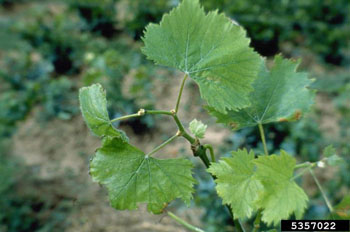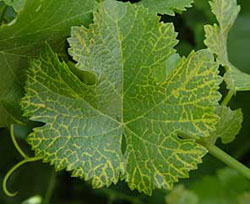Symptoms Management Options Causes More info
Stephen Jordan, University of Wisconsin-Madison
Symptoms
Grapevine fanleaf degeneration disease has two distinct syndromes, or sets of symptoms, depending on the virus strain and host response to infection. In the first syndrome, infectious malformations, the vines may be stunted or show reduced vigor. Leaves are severely distorted, asymmetrical, cupped and puckered, and exhibit acute dentations. These typical foliar symptoms resemble a fan, hence, the name of the virus and the disease (Figure 1). Yellow mottling may sometimes accompany foliar deformations. Canes are also malformed, showing abnormal branching, double nodes, different length or exceedingly short internodes, fasciations, and zigzag growth. Foliar symptoms develop early in the spring and persist through the vegetative season, although symptoms may be difficult to find in fully grown canopies later in summer.
Figures 2 and 3. Grapevine fanleaf virus symptoms – yellow mosaic pattern on leaf (L) and bright yellow vein banding on leaf. Photos courtesy of Canadian Food Inspection Agency.
The second syndrome, yellow mosaic, is caused by chromogenic virus strains. Affected vines show chrome-yellow discolorations that develop early in the spring and may affect all vegetative parts of the vines. Chromatic alterations of the leaves vary from a few scattered yellow spots, sometimes appearing as rings and lines, to variously extended mottling of the veinal and/or interveinal areas, to total yellowing (Figures 2 and 3). In spring, affected plants in a vineyard can readily be spotted from a distance. Malformations of leaves and canes are usually not prominent, but clusters may be smaller than normal and may have shot berries. In hot climates the newly produced summer vegetation has a normal green color, while the yellowing of the old growth turns whitish.
Crop losses can vary, with the potential for a total loss of production, depending on the virulence of the virus strain and varietal susceptibility. Fruit clusters are reduced in size and number with irregular ripening. Infected berries are uneven in size with numerous small and seedless individuals, some of which may not mature. Fruit quality is affected due to a decrease in sugar content and titratable acidity. The rooting ability of rootstocks and the graft take of scions are both substantially reduced in grapevine fanleaf virus (GFLV)-infected material. Also, the productive life of GFLV-infected vineyards is significantly reduced. Poor vine health also predisposes vines to winter injury and death in colder climates.
Cultural Management Options
- Plant healthy stock. Use planting material certified free of GFLV. Clones of most rootstocks and cultivars that have been tested and found to be free of all known viruses are available.
- Choose a rootsock that is both nematode and virus resistant, especially in areas with a history of GFLV.
- There is no way to cure an infected vine. Remove and destroy virus-infected vines. Top-grafting is not advisable, as rootstocks will be infected.
- Clean pruning equipment with a 1/10 dilution of household bleach between vines, as this may reduce vine-to-vine spread of the virus.
Chemical Management Options
Currently, there are no chemical control options for grapevine fanleaf degeneration disease.
Causes
Grapevine fanleaf degeneration disease is caused by the grapevine fanleaf virus (GFLV), a member of the nepovirus group. The natural host range for GFLV is primarily limited to species of the Vitis genus, so introduction to a new vineyard is likely through plantings of virus-infected nursery stock. Within a vineyard, GFLV is transmitted by nematode vectors in the dagger nematode group (Xiphinema index and X. italiae). Upon uptake of the virus, a nematode can remain viruliferous for nearly a year. When infected vineyards are removed, GFLV can survive for a number of years in root material left behind after vine removal.
Recommended Resources
Fanleaf Degeneration, Michigan State University
Fanleaf Degeneration, Purdue University
Fanleaf Degeneration, Cornell University
Major Grapevine Diseases: Fanleaf and Leafroll, Washington State University
Reviewed by Damon Smith, Oklahoma State University and Fritz Westover, Texas A&M University



